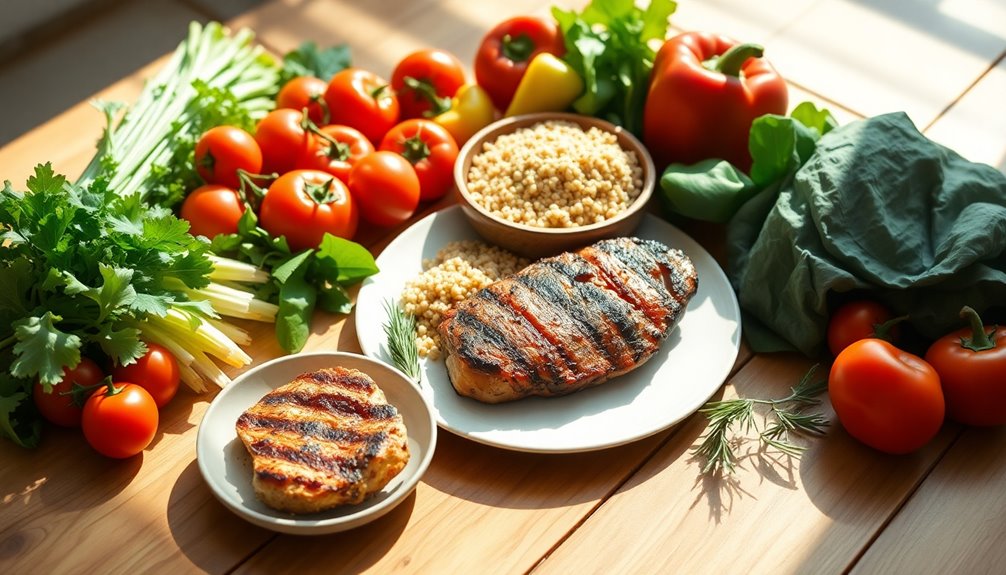The flexitarian diet is a flexible eating approach that emphasizes plant-based foods while allowing occasional meat consumption. It encourages you to enjoy a variety of fruits, vegetables, whole grains, and legumes, boosting your nutrient intake and supporting heart health. By reducing meat intake, you not only benefit personally but also lower your environmental impact. Making a shift can be simple; start with Meatless Mondays and explore new recipes. This diet promotes mindful eating and connects you with others who share similar health and sustainability values. Discovering more about this approach can help you make informed choices for your health and the planet.
Key Takeaways
- The flexitarian diet emphasizes plant-based foods while allowing occasional meat, promoting dietary flexibility and variety.
- This diet boosts heart health, lowers cholesterol, and aids in weight management.
- Incorporating diverse plant-based proteins, whole grains, and healthy fats enhances nutrient intake and overall wellness.
- Reducing meat consumption supports environmental sustainability by lowering greenhouse gas emissions and promoting biodiversity.
- Gradual adjustments, like starting with Meatless Mondays, facilitate an easier transition to a flexitarian lifestyle.
What Is a Flexitarian Diet?
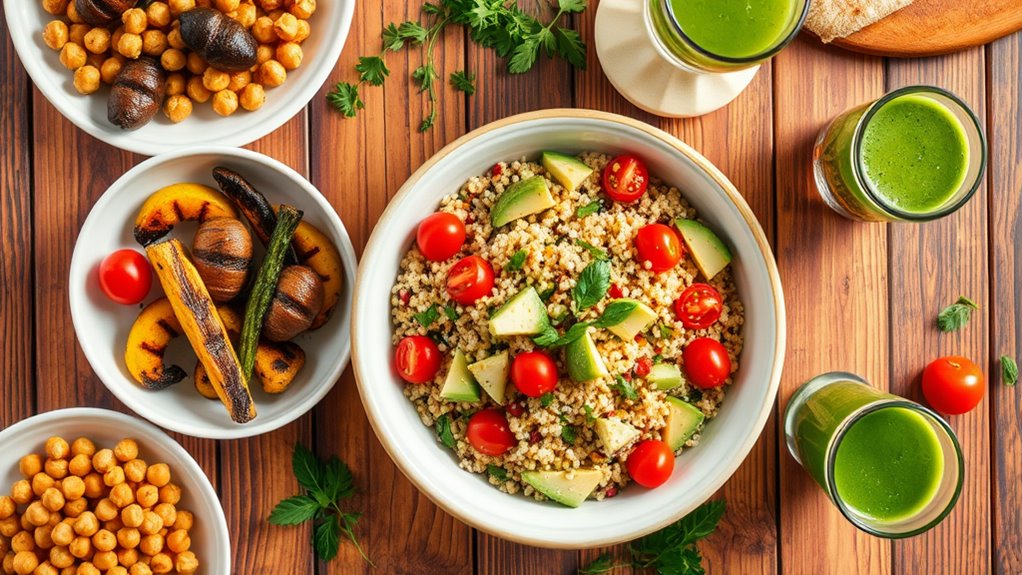
Embracing a flexible approach to eating, a flexitarian diet primarily focuses on plant-based foods while allowing for occasional meat and animal products. This way of eating combines the principles of vegetarianism with the flexibility of including meat, making it ideal for those who want to explore ethical choices without fully committing to a vegetarian or vegan lifestyle.
In a flexitarian diet, you'll find an abundance of fruits, vegetables, whole grains, legumes, nuts, and seeds. These plant-based foods not only provide essential nutrients but also help you feel connected to a community that values sustainability and animal welfare.
By reducing your meat consumption, you're making a conscious effort to lessen your environmental impact and support more ethical food systems. Adopting this diet can also lead to benefits such as a longer lifespan, similar to those experienced by individuals who fully commit to a plant-based diet.
The beauty of the flexitarian approach is that it offers you the freedom to enjoy your favorite meals while still promoting a healthier, more sustainable way of eating. You're encouraged to prioritize plant-based options, but you don't have to feel guilty about indulging in meat occasionally.
This balance allows you to foster a positive relationship with food while aligning your eating habits with your values.
Ultimately, adopting a flexitarian diet can help you feel a sense of belonging within a community that prioritizes ethical choices and mindfulness in eating. It's about making small, manageable changes and enjoying the journey toward a more balanced and compassionate lifestyle.
Health Benefits of Flexitarianism
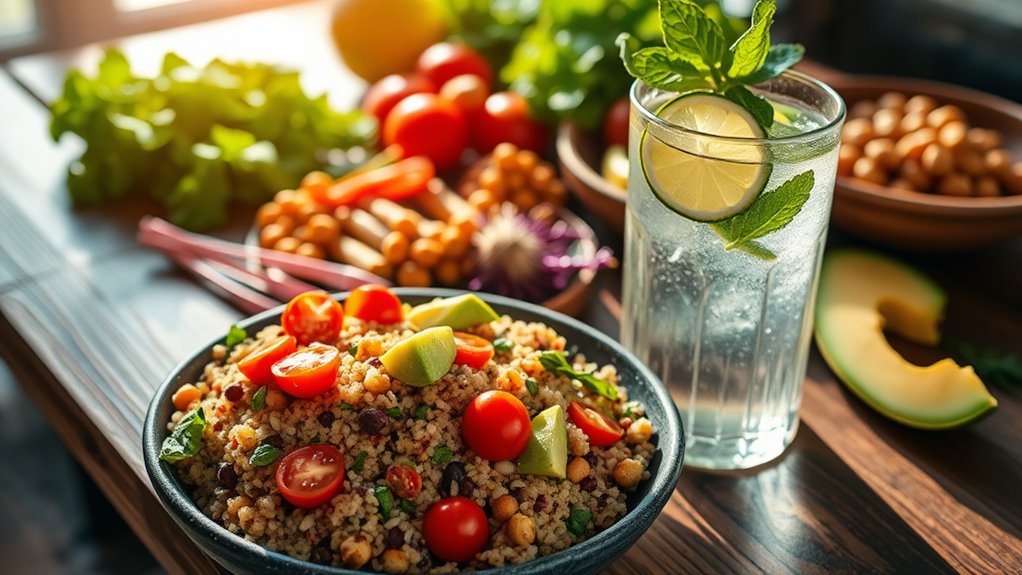
Following a flexitarian diet can lead to numerous health benefits that stem from its emphasis on plant-based foods. By incorporating more fruits, vegetables, whole grains, and legumes into your meals, you're likely to boost your nutrient intake. This shift can help improve heart health, as studies show that a diet rich in plant-centric foods can lower cholesterol levels and reduce the risk of heart disease.
Moreover, embracing a flexitarian lifestyle can assist in weight management. Research indicates that people who consume a mainly plant-based diet tend to have a lower body mass index (BMI) compared to those who eat more animal products.
Plus, flexitarian recipes often focus on high-fiber ingredients, which can keep you feeling fuller for longer and reduce unhealthy snacking.
Another significant benefit is the potential for better blood sugar control. A diet that prioritizes whole foods and minimizes processed options can lead to improved insulin sensitivity. This is particularly beneficial if you're concerned about diabetes or pre-diabetic conditions. Additionally, adopting a flexitarian approach can lead to a 600% increase in vegan diet adoption, allowing individuals to explore a broader range of delicious plant-based dishes.
Key Components of the Diet

At the heart of a flexitarian diet are its key components, which focus on incorporating a variety of plant-based foods while allowing for occasional meat and animal products. This approach offers you the flexibility in meals that makes it both sustainable and enjoyable. You'll find that plant-based proteins, such as beans, lentils, chickpeas, and tofu, play a significant role in your daily nutrition. These foods not only provide essential nutrients but also contribute to feelings of fullness and satisfaction.
In a flexitarian diet, fruits and vegetables take center stage. Aim for a colorful plate, as different colors often represent diverse nutrients.
Whole grains, like quinoa, brown rice, and oats, are also vital for energy and digestive health. Incorporating healthy fats from sources such as avocados, nuts, and seeds can enhance flavor and provide additional health benefits. Additionally, choosing whole-food sources of protein over processed options helps ensure you receive the maximum nutritional benefits from your meals.
While the focus is primarily on plant-based options, there's no need to completely eliminate meat or dairy. Instead, you can enjoy these foods in moderation, perhaps focusing on high-quality, sustainably sourced options when you do choose to indulge. This allows you to savor the flavors you love while still prioritizing your health and the environment.
Tips for Transitioning
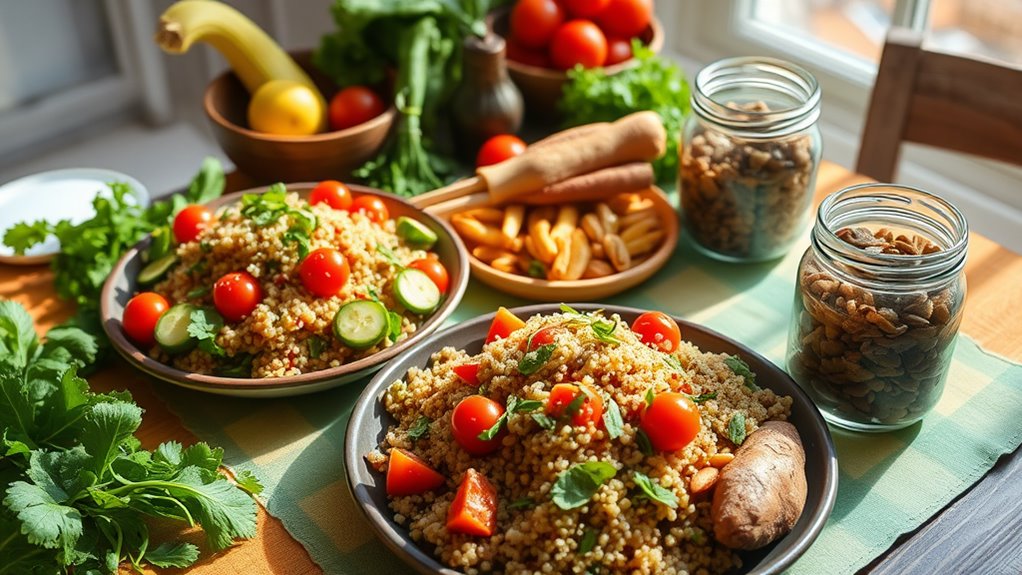
Shifting to a flexitarian diet can feel overwhelming, but it doesn't have to be. Start by making gradual adjustments to your eating habits. Instead of cutting out meat completely, try incorporating more plant-based meals into your week. Aim for a goal like "Meatless Mondays" to begin with—it's a manageable way to ease into this new lifestyle.
When it comes to grocery shopping, fill your cart with a variety of fruits, vegetables, whole grains, legumes, and plant-based proteins. Stocking up on staples like quinoa, beans, lentils, and nuts will give you a solid foundation for your meals. Don't forget herbs and spices; they can elevate any dish and keep your meals exciting.
Explore recipe ideas that align with your flexitarian goals. Try swapping meat for roasted chickpeas in salads or using cauliflower as a base for pizza crust. There are countless resources online and in cookbooks specifically designed for flexitarians, so don't hesitate to seek them out. Experimenting in the kitchen can be a fun way to discover new flavors and textures.
Lastly, connect with others who are also undergoing this change. Whether it's through social media groups or local meet-ups, sharing your experiences can help you feel supported and inspired. Remember, it's about finding a balance that works for you, not about perfection. Enjoy the journey, and celebrate your successes, however small they may be! Additionally, incorporating more plant-based foods can also support liver health, as fatty liver disease is often linked to modern diets high in processed foods.
Sample Meal Plans
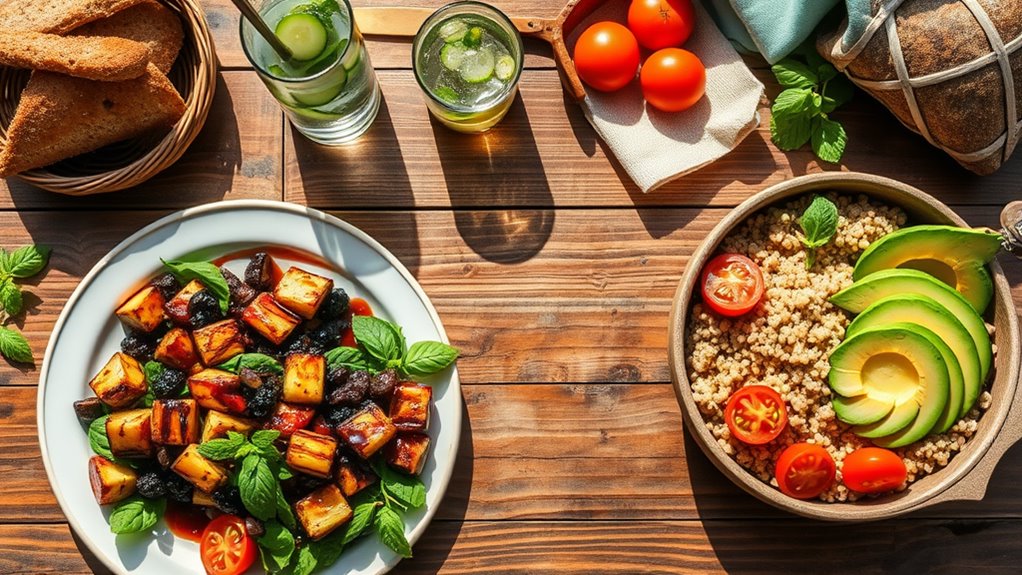
Creating a meal plan can simplify your shift toward a flexitarian diet, making it easier to incorporate more plant-based meals into your routine. A well-structured plan helps guarantee nutritional balance while keeping your meals exciting and satisfying. Here are some recipe ideas to get you started:
- Breakfast: Overnight oats with almond milk, chia seeds, and topped with fresh berries and a sprinkle of nuts. This meal provides fiber, healthy fats, and antioxidants to kickstart your day.
- Lunch: Quinoa salad with mixed greens, cherry tomatoes, cucumber, chickpeas, and a lemon-tahini dressing. This dish is packed with protein and essential vitamins, keeping you energized throughout the afternoon.
- Snack: Hummus with carrot and cucumber sticks. This healthy snack is rich in protein and fiber, making it a great way to curb hunger between meals.
- Dinner: Stir-fried tofu with mixed vegetables (like bell peppers, broccoli, and snap peas) served over brown rice. This meal offers a balanced combination of plant-based protein, vitamins, and whole grains. Additionally, incorporating gluten-free recipes can further enhance your meal options while aligning with various dietary restrictions.
Flexitarian Diet and Sustainability
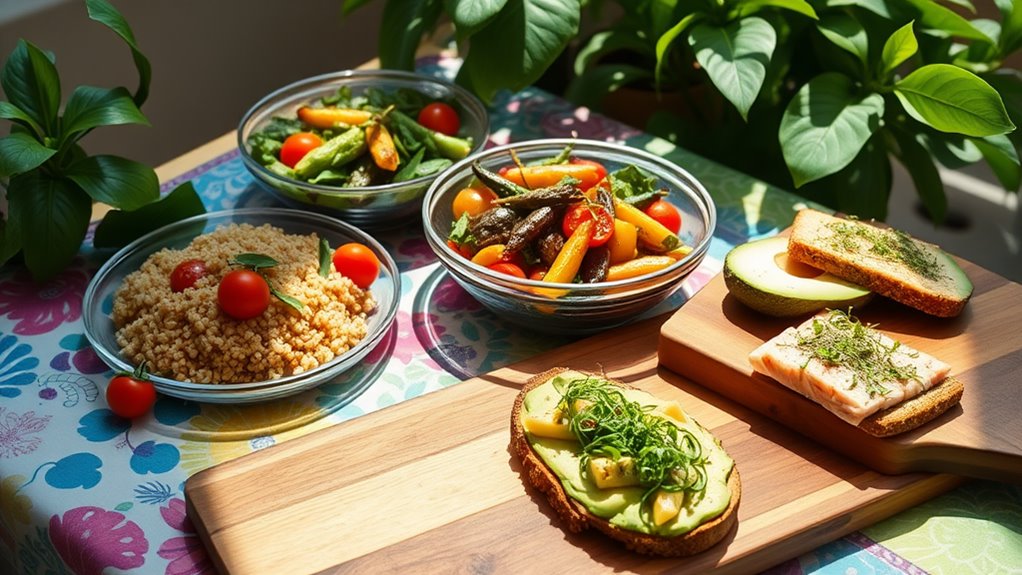
A flexitarian diet not only enhances your personal health but also greatly contributes to environmental sustainability. By making mindful food choices, you can reduce your environmental impact while still enjoying the flexibility of incorporating meat and animal products in moderation. Research shows that plant-based diets can considerably lower greenhouse gas emissions, decrease water usage, and reduce deforestation.
Here's a quick comparison to illustrate the sustainability benefits of a flexitarian diet:
| Food Type | Environmental Impact | Benefits of Flexitarian Choices |
|---|---|---|
| Red Meat | High greenhouse gases | Reduced consumption lowers impact |
| Poultry | Moderate greenhouse gases | Healthier protein choice |
| Plant-Based Foods | Low greenhouse gases | Supports biodiversity and soil health |
By focusing primarily on plant-based meals, you're not just choosing foods that are good for you, but also supporting a healthier planet. Each meal is a chance to reflect on your food choices and their broader implications. Following a flexitarian diet aligns with natural calorie cycles, promoting both personal health and ecological balance.
Whether you're enjoying a hearty vegetable stir-fry or a light chicken salad, remember that every small change contributes to a larger positive impact. The flexitarian diet embraces inclusivity, allowing you to connect with others who share similar values around health and sustainability. It's not about strict rules but rather about creating a lifestyle that honors both your body and the Earth. So, why not start today?
Frequently Asked Questions
Can Children Follow a Flexitarian Diet Safely?
Yes, children can follow a balanced diet safely with careful meal planning. You should guarantee they get enough nutrients by including a variety of fruits, vegetables, whole grains, and proteins in their meals. When packing school lunches, think about incorporating plant-based options along with lean meats or dairy for balance. With thoughtful choices, you can help your child enjoy a diverse diet that supports their growth and well-being while fostering a sense of belonging.
Are There Any Specific Nutrient Deficiencies to Watch For?
Exploring the nutrient terrain can feel like dancing through a garden of colors. When you're monitoring your child's diet, keep an eye on iron levels and Vitamin B12. Iron is essential for energy, while Vitamin B12 supports brain health.
Plant-based sources mightn't always fulfill these requirements, so consider fortified foods or supplements. It's all about balance—ensuring your child thrives while enjoying a varied, nourishing plate that brings everyone together.
How Does the Flexitarian Diet Compare to Vegetarianism?
When you compare the flexitarian diet to vegetarianism, you'll notice both emphasize plant-based foods, but flexitarianism allows occasional meat consumption. This flexibility can make it easier for you to enjoy a wider variety of foods while still reaping health benefits like reduced risk of chronic diseases.
Environmentally, both diets lower your carbon footprint, but the flexitarian approach can feel more sustainable for those who aren't ready to fully commit to vegetarianism.
Is the Flexitarian Diet Suitable for Athletes?
Yes, the flexitarian diet can be suitable for athletes. It offers performance benefits by providing a variety of nutrient-dense foods that support ideal protein intake, essential for muscle repair.
You'll find that incorporating plant-based options can enhance energy levels and reduce recovery time.
What Are Some Common Misconceptions About Flexitarianism?
Many misconceptions swirl around dietary choices, like leaves caught in a whirlwind.
You might think that eating flexibly limits your health benefits or that it's not impactful for the environment.
In reality, a balanced approach can enhance your well-being while reducing your carbon footprint.
It's not just about cutting out meat; it's about enjoying a variety of foods.
Embracing this lifestyle fosters community and connection, proving nutritious choices can be both delicious and sustainable.
Conclusion
So, if you're ready to immerse yourself in a flexitarian lifestyle, you can enjoy your veggies without swearing off bacon forever. It's like having your cake and eating it too, but with a side of kale. Research shows that this diet's not just good for your waistline; it's also a win for the planet. Who knew saving the Earth could taste this good? Engage in flexibility—your taste buds and the environment will thank you, one veggie taco at a time!

